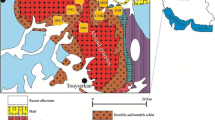Abstract
The physical properties of four evaporitic rocks, anhydrite, gypsum, potash and rock salt, were investigated. Their respective specific gravities and dry densities show little variation and all four rock types have low porosity values. Anhydrite is by far the strongest material both in unconfined compression and in tension, followed by gypsum, potash and rock salt, in that order. The hardness values of these four rock types follow the same order as the strength values, to which they have a highly significant relationship. All four rock types exhibit some amount of plastic deformation prior to failure, anhydrite the least whilst rock salt shows the most. The value of Young's modulus tends to increase as the value of density, strength and hardness increases. Incremental creep tests indicate that rock salt suffers appreciable creep before failure, as does potash. Gypsum undergoes much more creep before failure than does anhydrite.
Résumé
Les propriétés physiques de quatre roches évaporitiques—l'anhydrite, le gypse, la potasse et le sel—ont été examinées. Leurs poids spécifiques respectifs et leurs densités sèches ne varient pas beaucoup. Les quatre types de roches ont une porosité faible. En ce qui concerne la résistance à la compression et à la fraction, l'anhydrite est le matériau le plus résistant, suivi, dans l'ordre, par le gypse, la potasse et le sel. Pour la dureté, ces types de roches suivent le même ordre que la résistance, avec laquelle ils ont une relation très significative. Les quatre types montrent tous une certaine intensité de déformation plastique avant de se fracturer; la déformation de l'anhydrite est la moins grande cependant que le sel montre la déformation plastique la plus grande. Le module de Young tend à croître avec la densité, la résistance et la dureté. Les tests d'allongement croissant indiquent que les roches salées s'allongent considérablement avant de se fracturer, comme le fait la potasse. Le gypse s'allonge beaucoup plus avant la fracture que l'anhydrite.
Similar content being viewed by others
References
BELL, F. G. (1975): Salt and Subsidence in Cheshire, England. Eng. Geol., 9, 237–247.
BROCH, E. and FRANKLIN, J. A. (1972): The Point Load Test. Int. Jour. Rock Mech. Min. Sci., 9, 669–697.
COLBACK, P. S. B. and WIID, B. L. (1965): The Influence of Moisture Content on the Compressive Strength of Rock. Proc. Rock Mech. Symp., Canadian Dept. Min. Tech. Surv., Ottawa, 65–83.
DEERE, D. U. and MILLER, R. P. (1966): Engineering Classification and Index Properties for Intact Rock. Tech. Rept. No. AFWL-TR-65-115, Air Force Weapons Lab., Kirtland Air Base, New Mexico.
FARMER, I. W. (1968): The Engineering Properties of Rocks, Spon.
FRANKLIN, J. A. (1970): Suggested Methods for Determining the Slaking, Swelling, Porosity, Density and Related Rock Index Properties. Res. Rept. D12, Imperial College, London.
GEOLOGICAL SOCIETY ENGINEERING GROUP (1970): Working Party Report on the Logging of Cores for Engineering Purposes. Quart. Jour. Eng. Geol., 3, 1–24.
HARDY, H. R. (1966): A Loading System for the Investigation of the Inelastic Properties of Geologic Materials, Testing Techniques for Rock Mechanics. ASTM, STP 402, 232–265.
OBERT, L., WINDES, S. L. and DUVAL, W. I. (1946): Standardized Tests for Determining the Physical Properties of Mine Rock. U. S. Bur. Min. Rep. Invest. 3891.
RAMANA, Y. V. and VENKATANARAYANA, B. (1971): An Air Porosimeter for Determining the Porosity of Rocks. Int. Jour. Rock Mech. Min. Sci., 8, 103–118.
WALSH, J. B. (1965): The Effect of Cracks on the Uniaxial Compression of Rocks. Jour. Geophys. Res., 70, 399–411.
WOODS, P. J. E. (1973): Potash Exploration in Yorkshire, Boulby Mine Pilot Borehole, Trans. Inst. Min. Met. (Section B, Applied Earth Science). 82, 99–106.
Author information
Authors and Affiliations
Rights and permissions
About this article
Cite this article
Bell, F.G. Geotechnical properties of some evaporitic rocks. Bulletin of the International Association of Engineering Geology 24, 137–144 (1981). https://doi.org/10.1007/BF02595264
Published:
Issue Date:
DOI: https://doi.org/10.1007/BF02595264




